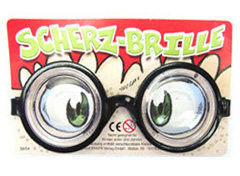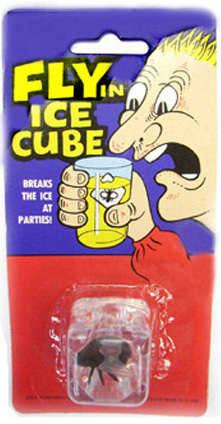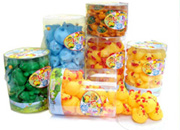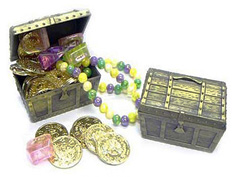
What is plastic?
¡@
Plastic is a polymer or chain of molecules with strings of
carbon and other elements, made from petroleum by linking chemical
reactions. There are so many different types with varying
properties. Bio-based plastics are being researched and developed,
but are not yet a feasible option in the toy business.
Thermoplastics such as Acrylic (Perspex), Acrylo-nitrile (Nylon),
Polyethylene (Polythene), Polyvinylacetate (PVA), Polystyrene (PS)
and Polyvinylchloride (PVC) soften with heat and harden when cold.
They can be recycled and re-used repeatedly. We use thermoplastics
in our products.
Thermosets such as Bakelite, Epoxy, Melamine, Polyester and
Polyurethane are cured or hardened by heat, and cannot be re-used
like thermoplastics.
Some plastics are spun into fibres, made into yarns and used
for weaving into textiles or made into ropes; some can be sprayed
as a coating, used as a glue, or used in paint. Plastics are used
in toys because they are easy to shape and colour, they can be
made soft or hard, flexible or stiff, they are good insulators, do
not rust, are lightweight, cheap and durable.
Our products are often made from Polyethylene (PE) for example
because it suits our products, methods and machines. PE is a
relatively environmentally friendly plastic. We use other plastics
according to product requirements. There are different qualities,
densities and types. Where suitable for some products we use
recycled plastic as the raw material.
Additives are used in the plastic raw material to give various
properties. Different plastics can contain all sorts of additives
such as plasticisers or softeners, flexibility agents, fillers,
reinforcement, pigments, flame retarders, antioxidants, blowing
agents, lubricants, heat stabilizers, UV stabilization, etc. etc.
We often add colouring to the plastic mass as necessary.
Although we are aware of the regulations in most countries, it
is prudent to specifiy to us any special requirements or
compositions, specific to the use of the product in your country,
and whether any special testing, analysis or certification is
required.
¡@


|
 |
 |
|
How is plastic shaped?
¡@
There are many different processing techniques commonly used in
the toy and plastics industry. Most involve the use of a mould.
Our factory uses the first two moulding methods.*
¡@
*Injection moulding: Plastic beads or pellets are melted under
heat and shear energy and injected under pressure into a steel
mould to give the required shape. The mould cavity is essentially
a negative of the part being produced. Our factory uses this
method predominantly.
¡@
*Blow moulding: Plastic material is forced into a closed mould and
compressed air is used to blow a "bubble" inside the plastic. The
plastic swells out like a balloon until it fills the mould and the
required shape is obtained. WE make dolls, soft and hollow toys
using this method. (Plastic bottles can also be made this way.)
¡@

Rotational moulding: Plastic material is placed in a mould over a
burner, and the mould is rotated to achieve a uniform wall
thickness. Large hollow toys, water tanks and barrels can be made
this way.
¡@
Extrusion: Hot molten plastic is forced through a nozzle to make
pipes, tubes, jointing strips such as used in the building
industry, and also large sheets that can be used later in
thermoforming.
¡@
Blow extrusion: This is used for making plastic bags and films. An
extruded tube with a sealed end is blown up like a balloon while
still hot, stretching the plastic to make it thin.
¡@
Thermoforming: The plastic sheet is heated to near its softening
temperature, and then pressure is placed on it with a male and /
or female mould to produce the required shape. This method is used
to make trays, cups, masks and boards.
¡@
Vacuum forming: Sometimes pressure and vacuum are used in the
thermoforming process and maximum uniformity of thickness and
strength can be obtained. Packaging for biscuits and
confectionery, cosmetics, disposable cups and containers for
youghurt can be made this way.
¡@
Slush moulding: This involves filling a hollow mould with a
solution of plastic material heating the mould to gell an inner
layer or wall of material in the mould, and then inverting the
mould to pour out the excess material. After cooling the finished
part can be removed. This is used to make hollow objects.
¡@
Dipping: The mould is dipped into a plastic solution and the
coating is fused to make the item. Soft flexible toys such as
balloons, handlebar grips, and flexible covers can use this
technique.
¡@
Fabrication: Plastic sheets can be fabricated into tanks, acrylic
signboards, and other industrial articles by cutting, folding or
bending and glueing.
¡@ |
  |
 |
|
Our production process
¡@
Let's assume we are going to create an entirely new product.
¡@
Of course if you choose to use one of our existing products
the delivery time will be faster.
¡@
Or you may wish to have a logo or message printed on one of
our existing items. This is also very quickly done, and we
just need to allow for making the samples and sending them to
you for approval. Some of our products have an ideal shape for
block-printing (football jersey, heart, smiling face,
paperclip...)
¡@
It is best to ask us about delivery times as our workload can
vay according to the time of the year. The order quantity is
also a factor. We can usually deliver large orders in phases
to suit your schedule and suitable shipping volumes. It is
prudent to allow a minimum of 5 or 6 weeks for shipping each
delivery from Hong Kong or China to your nearest port. We can
also air freight the first production batches for you if time
is short.
¡@
It is important to consider:
¡@
Manufacturing process: Blow moulding minimises the material
quantity used and gives a soft, flexible, light and cheap
product that can be very cute. However if it needs to be
painted care needs to be taken to ensure the paint sticks.
Injection moulding can be used to create more complex shapes
and is easier to paint and finish.
¡@
Material: What is the final use of the product? Contact with
food items? Child's toy? Flexible item? Bendable item? Hard or
soft plastic? Erase? These facrtors will affect the choice of
the plastic type.
¡@
Size: If too large there are more material costs, more volume
and weight to transport. If the object is too small, and there
is a lot of detailed painting to be done in several colours,
then finishing is difficult, time consuming and good quality
is difficult to maintain. Certain sizes may be dangerous for
young children (swallowing). If it is a capsule item, then its
size must just fit the capsule for which it is intended.
¡@
Shape:The object must have a shape that allows it to be
successfully injected or formed and then removed from the
mould. Usually the mould is in two half pieces with a flat
interface at the joint. Re-entrant or undercut shapes can make
it difficult or impossible to remove from the mould, and
twoseparate moulds may be needed, which will increase the
tooling costs. Sometimes a small and acceptable change to the
shape will solve such problems. If a separate piece is
nevertheless required, the piece will be glued, so agreement
on the type of fixing and glue is needed. Sometimes a very
flexible plastic will permit de-moulding when it would
otherwise seem very difficult or impossible. (e.g. spiky
balls)
¡@
If the item is for a key chain then a loop or other provision
for attaching the chain and ring will be incorporated in the
mould. Very often a hole will be placed in the bottom so that
a pencil topper version of the object can also be produced,
and the volume of material is slightly reduced.
¡@
Painting and colours: If there is a predominant colour then
this will be applied in the mass. Glitter and other effects
can also be applied. Spray painting can be used for rainbow
and other effects.
¡@
Incorporated items: Are there any small objects to be built
in, like lights with a small battery, metal attachments,
provision for fixing screws and the like?
¡@ |
 |
|
|
 |
|




